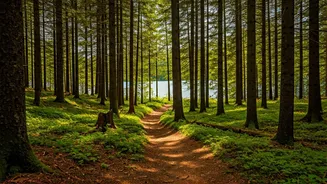Forest's Scenic Beauty
Hiawatha National Forest presents a tapestry of natural splendor that enthralls visitors. Spanning across Michigan's Upper Peninsula, the forest showcases
a rich blend of environments, including the tranquil shores of the Great Lakes and the dense, age-old forests. The terrain shifts from rolling hills to expansive wetlands, each section presenting a unique allure. The presence of numerous lakes and streams further enriches the landscape, providing habitats for a range of wildlife. During the warmer months, the forest explodes with vibrant colors as wildflowers bloom, creating striking vistas. The varied ecosystems support diverse plant life, from the tall pines that dominate certain areas to the deciduous trees that put on a colorful display in the fall. The forest's abundant natural resources provide opportunities for exploration and contemplation, inviting visitors to immerse themselves in nature's serene embrace. In winter, snow transforms the forest into a picturesque wonderland, offering snowshoeing and cross-country skiing opportunities, while in the warmer months, the forest becomes an inviting retreat for outdoor activities. This constant transformation throughout the year ensures a unique and engaging experience during every visit, underscoring the dynamic beauty of Hiawatha National Forest.
Explore Diverse Ecosystems
The Hiawatha National Forest is distinguished by its varied ecosystems that contribute to its rich biodiversity. Coastal areas, which interface with Lake Superior and Lake Michigan, support ecosystems adjusted to the water's influence. Here, visitors may see a selection of plant and animal species adapted to a water-dominated environment. Inland, dense forests of various tree species, including pines, maples, and birches, shape the core of the forest's environment. These forests offer homes for diverse animals, ranging from small mammals to migratory birds. Wetlands and bogs are found throughout the forest, creating crucial habitats for many plant and animal species, including unique bird species and many invertebrates. These sensitive wetlands play a pivotal role in the local water cycles, assisting in filtering and storing water, maintaining the overall health of the forest. The forest's ecosystem diversity extends to its streams and lakes, where aquatic life thrives. Many fish species inhabit these waters, offering opportunities for anglers. The forest management approach focuses on preserving these different ecosystems by managing forest resources and maintaining the habitats of diverse wildlife. The forest also focuses on monitoring the ecosystem, managing habitats, and promoting the health of the ecosystems, supporting the forest's long-term sustainability and enjoyment.
Outdoor Adventures Await
Hiawatha National Forest provides many options for outdoor activities. The forest provides a multitude of recreational opportunities throughout the year, from leisurely strolls to challenging adventures. Hiking and backpacking are common activities, with a variety of trails suited to different fitness levels. Trails range from easy, family-friendly routes to challenging, multi-day backpacking trips through the forest's core, giving panoramic views and deep forest experiences. The forest's numerous lakes and rivers provide opportunities for water-based recreation. Visitors may swim, canoe, kayak, or fish in serene waters. Numerous lakes and rivers invite boating and fishing, attracting outdoor lovers. The forest also has designated campgrounds, allowing visitors to stay overnight in contact with nature. These campgrounds offer basic amenities and access to hiking trails and waterfronts. In winter, the forest is transformed into a winter wonderland, where people enjoy skiing and snowshoeing on groomed trails and through unspoiled scenery. The forest offers several opportunities to engage with nature and enjoy outdoor activities throughout the year. The National Forest welcomes visitors of all skill levels, offering experiences in different seasons.
Wildlife Encounters
The Hiawatha National Forest is a paradise for animal life. The varied ecosystems support a rich variety of animal species. Visitors have the opportunity to experience the natural beauty and encounter some of the animal life that live in the forest. Bird watchers will find many species, especially during migrations. Various species of waterfowl, songbirds, and birds of prey create an engaging landscape for bird watching. Mammals, including white-tailed deer, black bears, and various small mammals, can be found throughout the forest. While bear encounters are uncommon, hikers should be aware and take precautions. The forest also houses several species of reptiles and amphibians that are part of the ecosystem. Forest management and conservation practices play a role in wildlife conservation. Preserving the forest's habitat through sustainable logging practices and the preservation of wetlands ensures animal populations will thrive. The forest is managed to guarantee a healthy environment that allows animals to flourish. Visitors should follow rules such as staying on established trails and not feeding animals to ensure safe interactions and protect wildlife habitats. For anyone interested in animals, the Hiawatha National Forest offers chances to see the natural world, enhancing their appreciation for nature and wildlife conservation.






